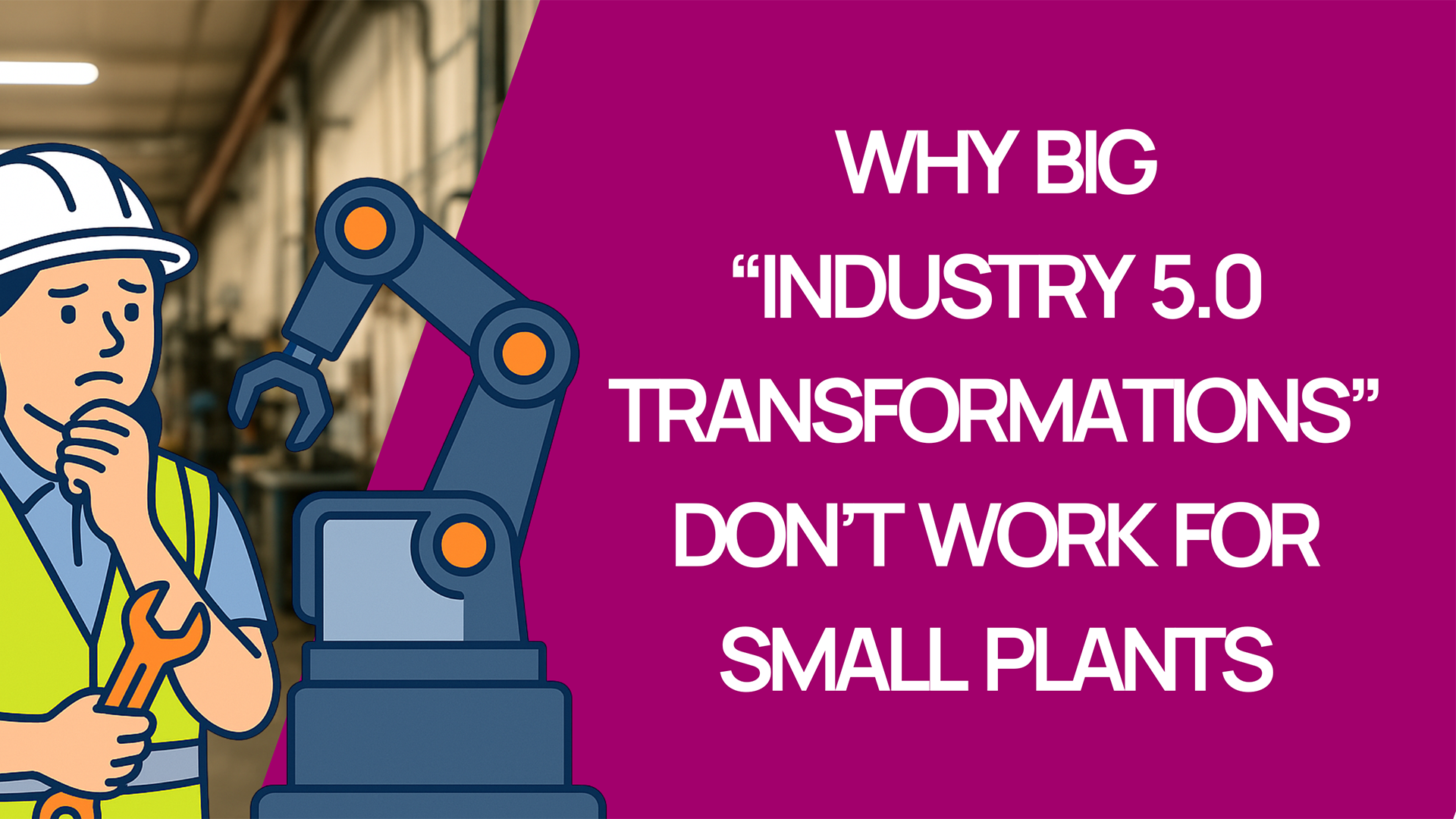Introduction
You’ve heard the buzz: Industry 5.0. It’s human-centric! And robotics, AI, digital twins! Everything working in harmony!
Vision statements promise factories of the future with maximum automation, perfect quality, and sustainability baked in.
Sounds great.
But for many small plants in the U.S., chasing a full-scale Industry 5.0 transformation often leads to stalled projects, overspending, and distraction from where real profit lies.
In fact, we’ve heard industrial professionals express their frustration quite bluntly:
“Whoever talks about Industry 5.0, 4.0, or any other ‘point oh’ is full of crap.”
— Long-time industry professional
So yes, executives certainly have a gut-level sense for that problem of the unfulfilled promise of Industry 4.0, 5.0, “and any other point oh”.
But could you describe specifically why is that transformation often more trouble than it’s worth in reality?
Our take: At the end of the day, it’s because many of the assumptions behind Industry 5.0 business cases are built for global-scale companies, with high investment, deep technical teams, and tolerance long timelines.
In smaller companies, those assumptions don’t match reality, and “transformation” quickly becomes something you pay for but never fully get.
In this post, we’ll dig into why big Industry 5.0 transformations often fail in smaller plants, the data and research that back this up, and what lighter-weight, smarter alternatives really work for reaching similar goals … and even making progress toward the Industry 5.0 vision that you may still wish for long-term.
What the Research Says: The Real Barriers for Small Plants to achieve Industry 5.0 outcomes
Recent studies of SMEs (Small and Medium-sized Enterprises) keep pointing to similar challenges:
- High cost of adoption, both initially and ongoing
- Researchers who summarized 100+ recent studies for Results in Engineering found that small manufacturers struggle especially with the financial burdens of Industry 5.0 tech: robotics, full automation, digital twin systems, sensor networks, expensive staff … it all adds up. In the end, you’re looking at lots of things that cost lots of money, both for the up-front capital and for maintenance and integration costs, which often outstrip what the typical SME can budget.
- Unfortunately, the problem persists no matter manufacturers’ goals. The study we mentioned above focused on Industry 5.0 for business efficiency and profits. But other researchers found the same cost barriers when they studied automation implemented to improve environmental sustainability. And they, too, found that automation-heavy technologies frequently require larger investment and longer payback periods that many small plants can’t afford without external funding.
- Researchers who summarized 100+ recent studies for Results in Engineering found that small manufacturers struggle especially with the financial burdens of Industry 5.0 tech: robotics, full automation, digital twin systems, sensor networks, expensive staff … it all adds up. In the end, you’re looking at lots of things that cost lots of money, both for the up-front capital and for maintenance and integration costs, which often outstrip what the typical SME can budget.
- Skills and workforce gaps
- Studies like the recent “Human-centered SME factories” paper point out that small plants in many regions lack staff (and access to a wider labor pool) with the advanced skills and experience that Industry 5.0 demands. Think areas like data science, robotics, advanced control systems, or even basic sensor networking.
- Plus, re-skilling existing operators is costly in downtime and risk, researchers found. Teams need not just technical skills, but digital fluency and general change management, too. Small plants often don’t have the luxury of the extensive training budgets and operator time away from the floor that it can take.
- Studies like the recent “Human-centered SME factories” paper point out that small plants in many regions lack staff (and access to a wider labor pool) with the advanced skills and experience that Industry 5.0 demands. Think areas like data science, robotics, advanced control systems, or even basic sensor networking.
- Technology complexity and integration challenges
- The “Human-centered SME factories” study mentioned above also highlighted the problems that come with the relentless, ongoing speed of change that manufacturers face. Specifics differ by region. But topics like data privacy, new regulatory standards, cybersecurity all end up causing trouble for factories just to keep up with what “good” Industry 5.0 even looks like in their context.
- In addition to the problems we’ve already discussed, another SME-focused study points out just how many compatibility issues, security concerns, and integration headaches companies face when they need to integrate multiple systems (IoT sensors + cloud + robotics + AI), each of them already complex on its own. The study offers solutions. But many small plants don’t have and can’t afford the advanced IT teams that it takes to manage topics like big-data analytics, cloud computing management, or blockchain, never mind implementation or major upgrades for these technologies. The study describes solutions.
- And let’s not forget that all of these challenges sit atop the fact that it’s already hard to run a factory and keep all its systems functioning right, even today! Every site is different, as we see in our own work with customers across multiple industries. Just keeping sensors working, collecting reliable data, and ensuring quality signals (vs. noise) in a working production environment is often harder than it sounds. Environmental factors, maintenance, and calibration all matter, too. Adding Industry 5.0 on top of all that can seem downright delusional.
- When it comes to sustainability specifically, Industry 5.0 promises sustainable operations (less waste, circular design, etc.). But those payoffs come with extra complexities. The research shows that sustainable technologies in particular can make the “manufacturing tapestry … increasingly complex and interwoven.” Said simply, your teams and stakeholders have a lot to study and get right to achieve the benefits that can be had in theory.
- Long outcome lag times and high risk
- Small changes tend to produce value faster than big overhauls. But large Industry 5.0 plans often assume big scale outcomes (zero defects, fully autonomous robots, etc.) that take years to achieve post-implementation. For many SMBs, waiting years means cash flow, competitive position, and customer demands change. It’s just not realistic.
- Also, there is risk: if you spend heavily on new tech without solid baseline data visibility (what your actual downtime, quality losses, idle time are), you may invest in the wrong places for optimal ROI. That, too, turns out to plague transformation efforts. You’d almost want to know the data from Industry 5.0 to know how to implement it.
- Small changes tend to produce value faster than big overhauls. But large Industry 5.0 plans often assume big scale outcomes (zero defects, fully autonomous robots, etc.) that take years to achieve post-implementation. For many SMBs, waiting years means cash flow, competitive position, and customer demands change. It’s just not realistic.
All said and done, the challenges that can bar you from implementing Industry 5.0 transformations with confidence can seem significant.
What These Challenges Look Like on the Ground
But we’re well aware that this has been all just data from other companies, in total.
But how might it look at your actual site?
You may have experienced them if you have ever seen issues like these in your plants:
- A plant invests in robots and new AI-driven predictive systems. But without staff who understand data pipelines, sensor maintenance or change-management, the sensors degrade, false alarms dominate, staff revert to old manual checking. Project costs balloon. Leaders can’t trust answers at a glance and stop paying attention. Tools stop being used or go down outright.
- Or you may have seen sites invest in digital twins and cloud analytics tools. The tools come online in demo environments somewhat fast. But it takes huge chunks of time and money to integrate them with legacy machines. Transition periods are plagued by unplanned downtime and confusion that interrupts SOPs and busts production quotas or delivery deadlines. ROI pushes out 3-5 years, no matter that lenders or internal budget reviews demand payoffs in 12-18 months.
- Or have you seen this? A factory implements new digital technology. The tech comes online fast. Teams review the data it spits out. And then the questions mount: Baseline data may not be comparable, and improvements are hard to gauge. Or maybe the reports that the new tech produces are so dense that it’s hard to understand what it all means for daily work.
- Once in a while, you may even hear of this issue: A factory installs new tech. It works. But then, plant mangers get in trouble with finance or higher-ups in the next quarterly review anyway. The new tech improved production. But executives actually wanted other improvements, it turns out. They just never said it explicitly, nor stopped the investment. And so the company may now be more “digital” but have bought the wrong kind of tools.
Conclusion: What Small Plants Should Do Instead
Big transformations are tempting in presentations and industry reports.
But for small plants, the safer, more profitable path is incremental, grounded in real data, and built around what you already have.
Here are practical alternatives (without waiting for full Industry 5.0):
- Start with high-resolution energy and machine monitoring rather than full robotics or full automation. Get practical insights into unexpected idle times, machines running unnecessarily, and inefficient inrush, not to mention detailed insights into each machine’s operation. With that kind of data, you’ll inevitably find low-cost, high-impact opportunities. And if you can get that data from read-only tools, the risk to your production is much lower because you don’t need to modify machine operations.
- Measure first: understand your real baseline (downtime, scrap, speed losses) before buying anything big. Data drives better decisions.
- Demand goal clarity: get clear and stable priorities from leadership. Nothing better than knowing up-front that the “improvement” you make matches what they actually value.
- Small-scale automation: focus on filling specific gaps (e.g. measuring vs. human data entry, automating small repeatable tasks), not wholesale change. The benefit is smaller than from wholesale change. But you’ll build practical skills with digital transformation. Once you are ready for bigger changes, you’ll already have one (or more!) implementations under your belt.
- Build skills gradually: invest in small operator training, data literacy, basic sensor deployment and upkeep gradually. That way, you don’t need to pull anyone off the floor for very long. This takes some planning, to ensure continuity of skill-building. But that forethought is well worth it.
- Reuse and retrofit: Often, you can get big gains by improving what you already have — predictive maintenance in particular, but also optimizing settings, or scheduling better. Just because these efforts don’t “sound” futuristic, they can offer significant benefits.
Final Thoughts
Industry 5.0 may be the future roadmap, but it’s not a one-size-fits-all solution. And you’re best off not to implement it all at once.
For small plants in the U.S., chasing digital transformation wholesale can distract from what matters most: running reliably, achieving high quality every shift, and staying profitable despite the curveballs thrown by the wider context of politics, the economy, and more.
Smaller manufacturers who win and carry their tradition and quality into the new, digital production world are those who do the basics really well as ever, measure honestly, and take smart, incremental steps.
That’s true transformation that fits small plants—and delivers real return.

